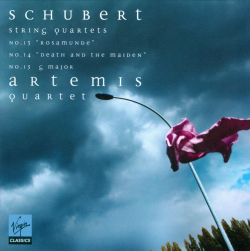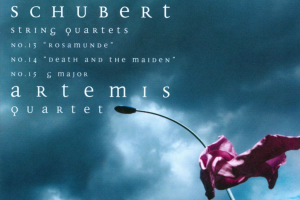
It’s one of the most difficult things to get around in late Schubert (if it’s even fair to refer to a composer’s “late period” when he died at 31). You, the listener, are there, comfortably enveloped in sweet melodic and harmonic bliss, when someone, evidently without reason or provocation, throws a rock at your head. Since the “someone” is Schubert, and he is hardly in a position to make you listen, you really haven’t a grievance so much as a puzzlement. Why?
The last three Schubert string quartets are crammed with rock-throwing incidents. “Death and the Maiden” (D. 810) at least gives you fair warning upfront that you are in for some tempestuous stuff. Its predecessor, D. 804, is named the “Rosamunde” by virtue of its quoting a number from Schubert’s “Rosamunde” incidental music in its second movement. If that suggests something blithe and carefree, brace yourself before listening. The last of all, the huge G-Major Quartet (D. 887), is also the strangest. It contains passages of utter serenity, passages of extreme violence, and things that honestly haven’t precedents of any kind.
Listen To The Music
Quartet in D Minor, D.810: Scherzo

Related Article
Free MP3 Download
That the Artemis Quartet, in its newly released recording (a double CD), digs into the darker and harsher elements of the three pieces here might be explained by its having made these recordings in 2009, halfway through recording the Beethoven quartet cycle. Certainly, there’s a tone here — of menace and of brawn — that most quartets are fine with in Beethoven but seem to shy away from in Schubert, however obvious the prompts in the scores. There is also, though, a lovely, almost ecstatic lyricism. When this Schubert isn’t storming, it sings.
The rougher elements are purposely unadorned. The Artemis players have no problem with suave, vibrato-warmed sound, but equally they don’t mind stripping all the comforts off and giving you naked pitch (and sometimes even the scent of rosin dust). In the opening of the slow movement of “Death and the Maiden” you get both: the plain nonvibrato of the theme, except for the flames of vibrato to mark the small changes in dynamics. And every loud chord in all three works gets what I’m coming to think of as the “Artemis treatment”: no vibrato, slow bow, “grind it out.”
The performance displays extraordinary tenderness, and extraordinary agility, too.
Lest this suggest that the performances are unrelievedly brutal and brutalizing, they are not. The performance displays extraordinary tenderness, and extraordinary agility, too. The second theme of D. 887’s first movement, the trios of all three scherzos, the lilting finale of the “Rosamunde,” and the filigree passagework in the outer movements of “Death and the Maiden” — all are as gentle and as nimble as can be.
But there is also tremendous power — mostly submerged, yet liable to surface at any moment. Sometimes it happens even where a listener who knows the pieces in question backward and forward wouldn’t have expected it. A couple of passages in the second movement of the “Rosamunde” quartet (the movement that gave the work its name) positively startled me in their vehemence. There was also a place in the finale of “Death and the Maiden” that sent me scurrying for a score. The second violinist and the violist had taken what looks, on the page, like a boring figure — mostly a long-held note, while the first and cello are doing “interesting stuff” — and made something so arresting of it that I couldn’t believe I hadn’t heard it before.
The second violinist and the violist … made something so arresting of it that I couldn’t believe I hadn’t heard it before.
The Artemis went through a round of “musical chairs” in 2007 that’s unusual in any quartet: In one stroke, it lost its second violinist (or, rather, one of its violinists, because at that point the two were trading off) and its violist. At that point, Natalia Prischepenko (the remaining violinist) became first, and Gregor Sigl and Friedemann Weigle (formerly of the Petersen Quartet) joined the quartet as second violin and viola, respectively. Word comes this week that Prischepenko is retiring from the quartet, to be replaced by the young Latvian violinist Vineta Sareika, leaving the rich-toned and articulate cellist Eckart Runge the only founding member remaining. String quartets do become miniature cultures; after one has been around a certain length of time, it’s possible to assimilate a new member into the existing mélange. Still, I find it hard to imagine a Prischepenko-less Artemis. She’ll be missed.

